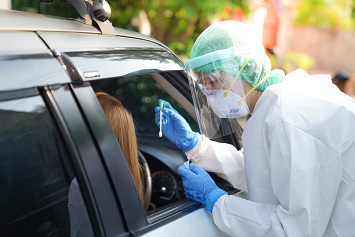The National Safety Council (NSC) urged Governor Larry Hogan (R-Md.), chairman of the National Governors Association (NGA), and Governor Andrew Cuomo (D-N.Y.), vice chairman of the NGA, to develop consistent testing and tracing protocols for coronavirus disease 2019 (COVID-19) infections. The NSC and a coalition that included state safety councils called on the governors of all 50 states to make effective testing and contact tracing protocols a top focus as state stay-at-home orders expire and workplaces reopen.
COVID-19 is a respiratory illness caused by the SARS-CoV-2 virus. COVID-19 currently is widespread in most U.S. communities and considered a workplace hazard.
On July 31, the NSC urged employers in Maryland and other states to include testing and contact tracing in their reopening plans.
“Fifty-four percent of Maryland residents with COVID-19 diagnosis were not working remotely when they tested positive, meaning traditional workplaces can be super spreaders very easily,” NSC president and CEO Lorraine M. Martin said in a statement.
“While state and local health departments are responsible for conducting COVID-19 case investigations and contact tracing, employers can help limit COVID-19 transmission in workplaces by increasing the speed and efficiency of these efforts,” Martin said.
The NSC also urged the states’ governors to work directly with employers to increase testing and contact tracing efforts, pointing out that up to 80% of individuals infected with COVID-19 are asymptomatic or have mild symptoms.
The NSC also called on governors to develop clear and consistent guidelines for wearing facial coverings in business, workplace, and public settings. Facial coverings limit coronavirus exposure from asymptomatic individuals, according to the NSC.
Earlier in the summer, the NSC issued a policy statement on COVID-19 contact tracing. The group urged employers to participate in contact tracing, as well as:
- Encourage employees to make use of technology or systems to determine employee contacts during their infection period.
- Seek employee buy-in for contact tracing, whether tracing is conducted by an app or through other means.
- Allow employees who were exposed to a sick individual (identified through contact tracing) to remove themselves from the workplace and self-quarantine according to Centers for Disease Control and Prevention (CDC) recommendations.
The NSC also said employers should notify local public health authorities of a COVID-19 diagnosis if an employee tests positive for COVID-19. The group recommended that employers work with local public health authorities to determine which contractors, customers, vendors, and other employees the infected employee came in contact with during his or her infection period while in the workplace. Employers, working with local public health authorities, should then notify other employees, vendors, and/or customers that they may have come in contact with an individual who tested positive or is presumed to have COVID-19.
Johns Hopkins Bloomberg School of Public Health Center for Health Security reviewed a number of contact tracing apps, according to the NSC. Contact tracing apps include:
- COVID-19 Watch from Stanford University, which uses Bluetooth signals to detect other app users in the area and can alert users anonymously if they were in contact with someone who was confirmed to be infected with COVID-19;
- CoEpi: Community Epidemiology in Action, another Bluetooth-based contact tracing app that offers self-reported symptom-sharing to support exposure notification even before the confirmation of test results; and
- Private Kit: Safe Paths, an app developed by the Massachusetts Institute of Technology that can be used with Safe Places to collect time-stamped location data using Private Kit: Safe Paths data, Google locator history, and individual interviews conducted by health departments.

